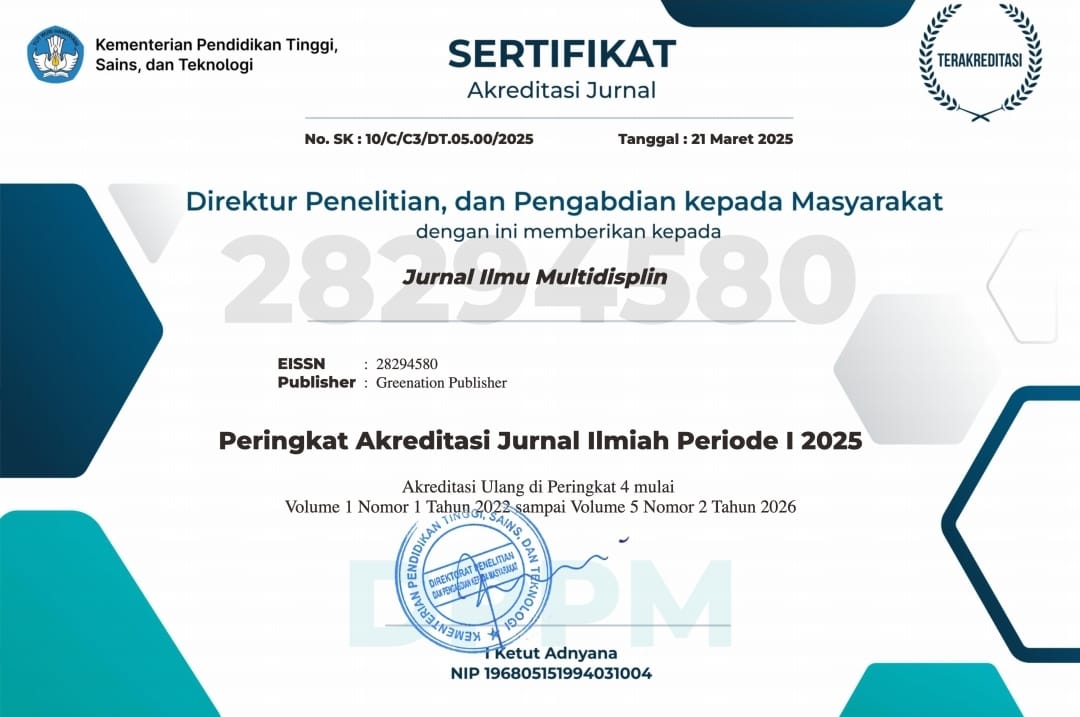Efektivitas Terapi Analgesik pada Diabetik Neuropati Studi Reprospektif di Rumah Sakit X Semarang
DOI:
https://doi.org/10.38035/jim.v4i4.1413Keywords:
Neuropati Diabetik, Gabapentin, Nyeri Neuropatik, Terapi Antinyeri, Luaran KlinisAbstract
Neuropati diabetik merupakan komplikasi mikrovaskular yang sering terjadi pada pasien diabetes melitus dan berdampak signifikan terhadap kualitas hidup. Penanganan nyeri neuropatik umumnya menggunakan obat antinyeri, namun efektivitasnya bervariasi antar pasien sehingga diperlukan evaluasi luaran klinis dalam praktik klinik. Penelitian ini mengevaluasi luaran klinis penggunaan obat antinyeri pada pasien neuropati diabetik berdasarkan penurunan skala nyeri. Penelitian ini merupakan studi observasional analitik dengan desain cross-sectional pada 241 pasien rawat jalan di Rumah Sakit X Semarang selama Agustus–Oktober 2024. Data diperoleh secara prospektif dari rekam medis pasien yang memenuhi kriteria inklusi, yaitu terdiagnosis neuropati diabetik, mendapatkan terapi antinyeri, dan memiliki data lengkap mengenai skala nyeri sebelum dan sesudah terapi. Penilaian nyeri menggunakan Visual Analogue Scale (VAS). Luaran dikategorikan baik jika terjadi penurunan ?1 poin dan buruk jika tidak ada perubahan atau nyeri meningkat. Analisis dilakukan secara deskriptif. Mayoritas pasien menunjukkan luaran klinis baik dengan penurunan skor nyeri rata-rata 2,24 poin. Gabapentin merupakan obat antinyeri yang paling banyak diresepkan, terutama dosis 300 mg (73,7%), yang memberikan penurunan nyeri rata-rata 2,25 poin dan luaran baik pada 66% pasien. gabapentin 100 mg digunakan pada 25,1% pasien, dengan penurunan rata-rata 2,21poin dan luaran baik pada 67% pasien. Penggunaan amitriptilin 12,5 mg (0,8%) dan Pregabalin 75 mg (0,4%) sangat terbatas, sehingga efektivitasnya belum dapat dinilai secara signifikan. Terapi antinyeri berbasis gabapentin, khususnya dosis 300 mg, memberikan luaran klinis optimal pada pasien neuropati diabetik. Pemilihan dosis yang tepat dan evaluasi rutin diperlukan untuk mengoptimalkan hasil klinis.
References
Berlin, R. K., Butler, P. M., & Perloff, M. D. (2015). Gabapentin therapy in psychiatric disorders: A systematic review. Primary Care Companion to the Journal of Clinical Psychiatry, 17(5), 330. https://doi.org/10.4088/PCC.15r01821
Chen, O., Cadwell, J. B., Matsoukas, K., Hagen, J., & Afonso, A. M. (2023). Perioperative gabapentin usage in pediatric patients: A scoping review. In Paediatric Anaesthesia (Vol. 33, Issue 8, pp. 598–608). John Wiley and Sons Inc. https://doi.org/10.1111/pan.14674
Delaney, A. J., & Crane, J. W. (2016). Presynaptic GABAB receptors reduce transmission at parabrachial synapses in the lateral central amygdala by inhibiting N-type calcium channels. Scientific Reports, 6. https://doi.org/10.1038/srep19255
Faienza, M. F., Chiarito, M., Molina-Molina, E., Shanmugam, H., Lammert, F., Krawczyk, M., D’Amato, G., & Portincasa, P. (2020). Childhood obesity, cardiovascular and liver health: a growing epidemic with age. In World Journal of Pediatrics (Vol. 16, Issue 5, pp. 438–445). Institute of Pediatrics of Zhejiang University. https://doi.org/10.1007/s12519-020-00341-9
Finegan, A., Mabrouk, U., & Nelson, L. A. (2020). Gabapentin-induced bilateral lower extremity edema in a patient with pervasive developmental disorder and schizoaffective disorder. Mental Health Clinician, 10(4), 250–253. https://doi.org/10.9740/mhc.2020.07.250
Gewandter, J. S., Burke, L., Cavaletti, G., Dworkin, R. H., Gibbons, C., Gover, T. D., Herrmann, D. N., Mcarthur, J. C., McDermott, M. P., Rappaport, B. A., Reeve, B. B., Russell, J. W., Smith, A. G., Smith, S. M., Turk, D. C., Vinik, A. I., & Freeman, R. (2017). Content validity of symptom-based measures for diabetic, chemotherapy, and HIV peripheral neuropathy. Muscle and Nerve, 55(3), 366–372. https://doi.org/10.1002/mus.25264
Hanania, J. W., George, J. E., Rizzo, C., Manjourides, J., & Goldstein, L. (2024). Agreement between child self-report and parent-proxy report for functioning in pediatric chronic pain. Journal of Patient-Reported Outcomes, 8(1). https://doi.org/10.1186/s41687-024-00774-0
Kantamneni, S. (2015). Cross-talk and regulation between glutamate and GABAB receptors. Frontiers in Cellular Neuroscience, 9(APR). https://doi.org/10.3389/fncel.2015.00135
Kocot-K?pska, M., Zajaczkowska, R., Mika, J., Kopsky, D. J., Wordliczek, J., Dobrogowski, J., & Przeklasa-Muszy?ska, A. (2021). Topical treatments and their molecular/cellular mechanisms in patients with peripheral neuropathic pain—narrative review. In Pharmaceutics (Vol. 13, Issue 4). MDPI AG. https://doi.org/10.3390/pharmaceutics13040450
Mian, M. U., Afzal, M., Butt, A. A., Ijaz, M., Khalil, K., Abbasi, M., Fatima, M., Asif, M., Nadeem, S., Jha, S., & Panjiyar, B. K. (2024). Neuropharmacology of Neuropathic Pain: A Systematic Review. Cureus. https://doi.org/10.7759/cureus.69028
Pang, L., Lian, X., Liu, H., Zhang, Y., Li, Q., Cai, Y., Ma, H., & Yu, X. (2020). Understanding diabetic neuropathy: Focus on oxidative stress. Oxidative Medicine and Cellular Longevity, 2020. https://doi.org/10.1155/2020/9524635
Qin, H., Li, G., Xu, X., Zhang, C., Zhong, W., Xu, S., Yin, Y., & Song, J. (2022). The role of oral microbiome in periodontitis under diabetes mellitus. In Journal of Oral Microbiology (Vol. 14, Issue 1). Taylor and Francis Ltd. https://doi.org/10.1080/20002297.2022.2078031
Raicher, I., Stump, P. R. N. A. G., Harnik, S. B., De Oliveira, R. A., Baccarelli, R., Marciano, L. H. S. C., Ura, S., Virmond, M. C. L., Teixeira, M. J., & De Andrade, D. C. (2018). Neuropathic pain in leprosy: Symptom profile characterization and comparison with neuropathic pain of other etiologies. Pain Reports, 3(2). https://doi.org/10.1097/PR9.0000000000000638
Rusbridge, C. (2024). Neuropathic pain in cats: Mechanisms and multimodal management. Journal of Feline Medicine and Surgery, 26(5). https://doi.org/10.1177/1098612X241246518
Sasaki, H., Kawamura, N., Dyck, P. J., Dyck, P. J. B., Kihara, M., & Low, P. A. (2020). Spectrum of diabetic neuropathies. In Diabetology International (Vol. 11, Issue 2, pp. 87–96). Springer. https://doi.org/10.1007/s13340-019-00424-7
Ssekamatte, P., Sande, O. J., van Crevel, R., & Biraro, I. A. (2023). Immunologic, metabolic and genetic impact of diabetes on tuberculosis susceptibility. In Frontiers in Immunology (Vol. 14). Frontiers Media S.A. https://doi.org/10.3389/fimmu.2023.1122255
Sylvetsky, A. C., Edelstein, S. L., Walford, G., Boyko, E. J., Horton, E. S., Ibebuogu, U. N., Knowler, W. C., Montez, M. G., Temprosa, M., Hoskin, M., Rother, K. I., & Delahanty, L. M. (2017). A high-carbohydrate, high-fiber, low-fat diet results in weight loss among adults at high risk of type 2 diabetes. Journal of Nutrition, 147(11), 2060–2066. https://doi.org/10.3945/jn.117.252395
Yang, X., Fang, P., Xiang, D., & Yang, Y. (2019). Topical treatments for diabetic neuropathic pain (Review). Experimental and Therapeutic Medicine. https://doi.org/10.3892/etm.2019.7173
Zhu, M., & Huang, H. (2023). The Underlying Mechanisms of Sleep Deprivation Exacerbating Neuropathic Pain. In Nature and Science of Sleep (Vol. 15, pp. 579–591). Dove Medical Press Ltd. https://doi.org/10.2147/NSS.S414174
Downloads
Published
How to Cite
Issue
Section
License
Copyright (c) 2025 Hikmawati Hikmawati, Maria Caecilia Nanny Setiawati Hadirahardja, Tri Murti Andayani

This work is licensed under a Creative Commons Attribution 4.0 International License.
You are free to:
- Share— copy and redistribute the material in any medium or format
- Adapt— remix, transform, and build upon the material for any purpose, even commercially.
The licensor cannot revoke these freedoms as long as you follow the license terms.
Under the following terms:
- Attribution— You must give appropriate credit, provide a link to the license, and indicate if changes were made. You may do so in any reasonable manner, but not in any way that suggests the licensor endorses you or your use.
- No additional restrictions— You may not apply legal terms or technological measures that legally restrict others from doing anything the license permits.
Notices:
- You do not have to comply with the license for elements of the material in the public domain or where your use is permitted by an applicable exception or limitation.
- No warranties are given. The license may not give you all of the permissions necessary for your intended use. For example, other rights such as publicity, privacy, or moral rightsmay limit how you use the material.



























